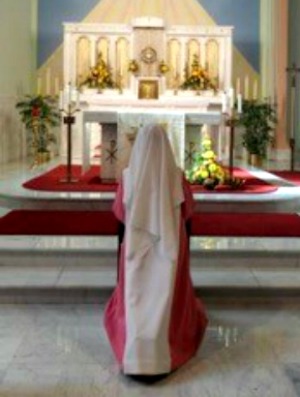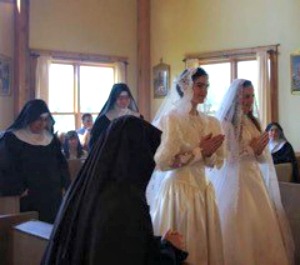Cloistered Communities Count Blessings as They Pray for More Vocations
How did the Year of Consecrated Life impact ‘hidden’ vocations?

On Feb. 2, Pope Francis ended the Year of Consecrated Life with a special Mass in St. Peter’s Basilica at the Vatican. But what fruits has the year delivered, in terms of highlighting cloistered religious communities and fostering more vocations there?
When the Holy Father, himself a consecrated religious, opened the special year on Nov. 30, 2014, he said he was doing so because he hoped the “shining witness of [the consecrated] life will be as a lamp,” placed where it can “give light and warmth to all of God’s people.”
As reported by the Register, His Holiness urged religious to “‘wake up the world,’ illuminating it with their ‘prophetic and countercurrent witness.’”
And yesterday, he praised the joyful witness of consecrated men and women: “How beautiful is it when we encounter the happy face of consecrated persons.”
By all accounts, religious’ response to the Pope’s call has led to a greater awareness of consecrated life.
Most of that attention was understandably focused on active religious, through congregations engaged in works such as teaching, outreach to the poor and health care.
The narrative of the last few decades tells of orthodox religious orders whose members wear habits as a distinct witness, reaping a great harvest of new members. Witness the phenomenal success of such congregations as the Dominican Sisters of Mary, Mother of the Eucharist (Ann Arbor Dominicans), the Dominican Sisters of St. Cecilia (Nashville Dominicans), the Society of Our Lady of the Most Holy Trinity (SOLT) Sisters and even Mother Angelica’s cloistered Poor Clares.
Cloistered communities, however, didn’t get as much exposure.
As Mike Wick, executive director of the Institute on Religious Life, put it, “They oftentimes seem to be forgotten,” adding that this stems from the “nature of their vocation.”
Indeed, according to the website ConsecratedLife.com, “Cloistered life is a formal way of life recognized by the Church to invite men and women to find within the hidden life of the monastery a place where they can experience the loving exchange of hearts with Christ Jesus.”
Perhaps because of this “hidden life,” many are struggling to attract new postulants.
When asked how many cloistered women religious monasteries exist in the United States, Wick admits there are no hard numbers. He says there certainly are “hundreds.”
He recently received a listing of cloistered Poor Clare communities in the United States, and it contained “ones I didn’t even know of.”

Besides obscurity, another factor hampering the growth of such orders in the Wi-Fi age is that less than 70 of the orders have an Internet presence. Many expect interested parties to send letters via mail.
To remedy this situation, the Vatican sent out a survey in 2015 to every known cloistered community around the world. It assesses numbers, needs and the impact of cultural and other factors.
Furthermore, according to Mother Agnes Mary Donovan of the Sisters of Life, chairwoman of the Council of Major Superiors of Women Religious, “Even beyond the initiatives of religious institutes to share with the young the call to religious consecration, the Church has begun to look at ways that it may better develop an awareness of the beauty of this vocation with the young, within the life of the Church.”
Attracted by Joy
All of this said, it isn’t as though women don’t choose cloistered communities. Many do, and their reasons are as varied as the monasteries they enter.
For instance, Sister Jacinta, 20, originally from Montana, chose the Benedictines of Mary in Gower, Mo. She discovered the community through a priest friend and says, “I could not get it out of my head how people could live in a [cloister] their whole lives. The thought wouldn’t leave me alone, and it went from a constant wondering to [where] I finally had to try for myself.”
She said, “I couldn’t perceive why the sisters were so happy, and their joy attracted me. When I looked at them, I thought, ‘They shouldn’t be happy and shouldn’t want to be here,’ but you could tell they didn’t want to be anywhere else.”
Passionist Sister Maria Faustina’s vocation was literally a calling, albeit a relentless one.
When the 25-year-old former Systems, Applications & Products consultant from Mason, Ohio, began her search, “the website to St. Joseph Monastery kept coming up.” Not knowing this, her spiritual director suggested the order as well. She always knew that if she chose religious life, she would be a contemplative, although not necessarily cloistered. She came to understand that “cloistered contemplatives are called to fight in the front lines of the spiritual battle” and “are called to be like Mary (of Bethany), sitting at the feet of Jesus. We give up the freedom to roam around physically in the world so that our souls have the freedom to fly to God.”

The faithful should also know about such orders as Philadelphia’s Holy Spirit Adoration Sisters, the so-called Pink Sisters, who just finished celebrating their centenary. They are faithful, and their charism is perpetual adoration. They wear distinctive habits, too, which most women who are interested in religious life value, as several surveys show.
And yet a community that was once 40 strong has dwindled to 20. This has compelled them for the first time in their history in the United States to do vocational outreach.
Discernment
Sister Mary Angelica of the Holy Spirit Adoration Sisters sees Pope Francis focusing people on the essentials and believes this will prove beneficial. Because, she maintains, “when we see God is important, we will see new hope in our lives as Christians and as Catholics. I think the vocations will really come if we focus on these essentials and if we deepen our faith as Christians.”
Benedictine Mother Maria-Michael, of the Abbey of St. Walburga in Virginia Dale, Colo., said discerning women must consider the right “fit” — contemplative, active or cloistered: “If you have a vocation, you have to figure out where you want to be.”
Because of these factors, Mother Catherine Marie, of the Passionist Nuns in Whitesville, Ky., stresses it is crucial to “devote the time to vocation animation and discernment. It takes a lot of time to do that properly, and yet it’s the future of the community.”
Toward this end, she has arranged for her vocation and novice directresses to receive training in Ignatian spiritual direction, “and that has been so helpful.” Her monastery also has a vocations blog, “and that’s how we’re getting our vocations.”
Indeed, the order has six relatively new women — including Sister Maria Faustina — all under age 32, and is in conversation with several others from around the nation.
Discernment help often comes in the form of open houses; congregations held many during the Year of Consecrated Life. According to the U.S. Conference of Catholic Bishops’ Father Ralph O’Donnell, 89% of 2014’s class of professed religious said they had participated in come-and-see weekends prior to becoming postulants.
“If those who entered in the past [because of open houses] is an indication of the future,” Father O’Donnell reasons that the Church should see more vocations, given the increased number of such events in 2015. This is especially true among cloistered communities, many of which never had open houses before.
Prayer Comes First
But, most of all, prayer is key.
Mother Catherine Marie says things really began to turn around 12 years ago, when the sisters began to actively pray for vocations. “Through Eucharistic adoration and Marian consecration — the foundation of monastic life — vocations flower.”
Mother Maria-Michael agrees prayer is essential: “We did have a number of people enter over the past year, which is lovely, so maybe it’s the fruit of [the Year of Consecrated Life]. But sometimes I don’t think we give enough credit to the fruit of prayer.”
Overall, religious are hopeful.
Said Mother Maria-Michael, “You can see an upswing very much in Eucharistic adoration. How can that not bear fruit in the Church?”
“The Holy Spirit is knitting together so many people in communion in the Catholic Church,” said Mother Catherine Marie. “It’s so exciting to witness this.”
Brian O’Neel writes from Coatesville, Pennsylvania.
- Keywords:
- benedictines
- brian o'neel
- dominicans
- pope francis
- sisters of life
- solt
- year of consecrated life














